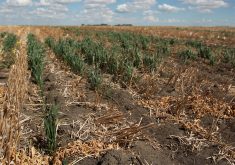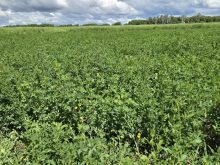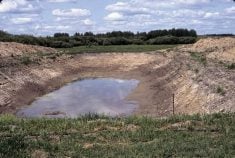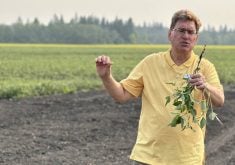Samples should be taken as close to freeze-up as possible to ensure nutrient analysis values do not change appreciably
Farmers need to know what nutrients are left in the soil once harvest is finished and the crop is in the bin.
That’s especially true this year, given stratospheric fertilizer prices and the likelihood of higher-than-normal residual soil nutrient levels following a year of low yields and drought-affected crop development.
“Certainly heat and drought played a big role in producing some yields that were less than anticipated this year,” said Warren Ward, an agronomy specialist with the Canola Council of Canada.
“The fact that yields were lower than expected presents some challenges and perhaps even some opportunities next year because with those lower yields, we’re expecting to see higher residual soil nutrient levels.”
Read Also

New program aims to support plant-based exports to Asia
Understanding the preferences of consumers in Taiwan and how they differ from Indonesia or Malaysia isn’t easy for a small company in Saskatchewan.
“That’s where soil testing comes in — to try and account for that (residual fertility) so we can go forward with the best plan.”
Ward said residual nutrient levels across Western Canada are likely to be highly variable from one region to another, and even from one area to another within the same field.
Saskatchewan Agriculture recently estimated average provincial yields of 21 bushels per acre for canola, 30 bu. per acre for hard red spring wheat, 19 bu. per acre for durum, 49 bu. for oats and 34 bu. for barley.
Those yields, which are well below average levels over the past five years, suggest that nutrient uptake was severely limited due to less-than-optimal soil moisture conditions.
Ideally, fall soil samples should be taken as close to freeze-up as possible.
This ensures that nutrient analysis values will not change appreciably between the time the post-harvest soil samples are collected and the time a new crop is planted the following spring.
Soils that have cooled to 10 C or lower are not conducive to microbial activity, meaning the vast majority of residual nutrients will still be available to cultivated crops the following spring.
In some cases, growers who anticipated further increases in fall nitrogen prices may have collected soil samples early in the post-harvest period, from relatively warm soil.
Sampling soils early can give the grower a wider window in which to make fertilizer buying decisions.
This is especially important in a year like 2021, with fertilizer prices at their highest level in more than a decade.
However, in many areas, rain during harvest and a relatively warm and frost-free post-harvest period have resulted in a late-season flush of second growth.
That could result in some residual nutrients being lost or tied up.
According to Ward, there are different ways to assess residual nutrient levels and fertility requirements for future crops.
Composite sampling is a cost-effective and proven technique.
To prepare a composite sample, growers should take 15 to 20 sub-samples from the most productive areas of a field — not from hilltops, low spots or saline areas.
Before blending the sub-samples, each soil core should be divided into two or three soil depths and placed into separate pails.
For example, when analyzing soil nutrient levels at three different depths, the cores should be divided into depths of zero-to-six inches, six-12 inches and 12-24 inches.
When analyzing at two different depths, divide the cores into samples taken at zero-to-six inches and six to 24 inches.
With the 15-20 sub-samples separated by depth into different pails, blend the soil in each pail thoroughly to create one composite sample per depth.
Each composite should be placed in its own sample bag.
For more precise fertility assessments, composite samples can be collected from various zones within a field, based on soil characteristics, drainage patterns or elevation.
Samples can also be collected according to automated field mapping systems.
Regardless of what technique is used, the key is to accurately assess existing nutrient levels and ensure that total fertility levels will allow the producer to meet established target yields.
“Basically, we want to know what’s in the soil and we want to have that yield target in mind so that we know how much fertilizer we’re going to need. The difference between the two is what we’re going to make up with our fertilizer application.”
With topsoil moisture in many regions of the Prairies at extremely low levels, it is widely expected that growers will be applying less fall nitrogen than usual this year.
Some producers may be tempted to take a wait-and-see approach by observing precipitation levels over the next six months.
In some cases, yield targets and fertility plans may not be finalized until next spring.
But the ability to source fertilizer products should always be considered, warned Ryan Furtas, who monitors fertilizer prices for Alberta Agriculture.
High fertilizer prices, caused by rising natural gas prices and supply chain disruptions, could mean that available stocks of nitrogen fertilizer will be lower than usual next spring.
Although Furtas does not anticipate any supply shortages in Western Canada, he advised growers to be in touch with their retailers as early as possible, and to avoid leaving buying decisions until the last minute.
Ward said proper fertility planning following this year’s drought may require a greater degree of foresight and flexibility.
Nonetheless, growers can still develop a fertility plan that adheres to the principles of 4R nutrient application and allows them to achieve normal target yields.
“We don’t know what next year is going to bring and we don’t want to plan for failure,” said Ward.
“I prefer to plan for success and still have some options open to me.”
“For example, maybe someone who’s accustomed to front-loading their fertilizer applications — so banding in the spring or fall or applying all of their fertilizer at seeding time — maybe that’s not the approach they’ll want to take next year.
“Maybe the right time to apply might not all be at, or prior to seeding. It might mean doing some split applications where they come in and apply some nitrogen during the growing season to respond to current environmental conditions at that time.”
There are a variety of top-dressing products available, including enhanced efficiency or coated nitrogen products that are less prone to gassing off.
However, applying these products can present challenges, particularly when it comes to properly timing applications and ensuring the availability of equipment and labour.
“Timing can become an issue. Logistics can become an issue and there may be weather that prevents you from getting into the field when you need to be applying that nitrogen,” Ward said
“I still like to see the majority of nutrients applied up front but when conditions become more variable, top-dressing is an option.”
To avoid unnecessary risk, top-dressing products should generally be limited to no more than 30 or 40 percent of overall nitrogen fertilizer requirements.
Ward encouraged growers to learn more about the flexible fertility options that are contained within the 4R nutrient program.
Canada’s canola industry has a goal to see 4R practices used on 90 percent of canola acres by 2025. The 4Rs of nutrient stewardship are right source, right rate, right time and right place.


















